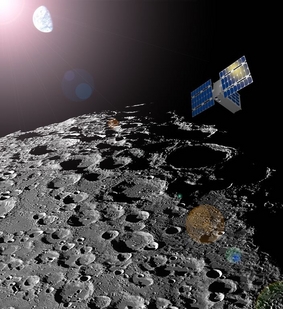Aug 26 2015
A spacecraft the size of a shoebox with Arizona origins will soon be orbiting our nearest neighbor to create a map of water-ice on the moon.
 An ASU-built CubeSat about the size of a shoebox will be used to produce a map of the water resources on the moon for future space exploration. It is the first ASU-led interplanetary mission. Photo by: Sean Amidan/ASU/SpaceTREx
An ASU-built CubeSat about the size of a shoebox will be used to produce a map of the water resources on the moon for future space exploration. It is the first ASU-led interplanetary mission. Photo by: Sean Amidan/ASU/SpaceTREx
The NASA-selected CubeSat will be designed, built and operated at Arizona State University and is one piece of the agency's larger mission to fully characterize the water content at the lunar South Pole in preparation for exploration, resource utilization and improved understanding of the moon’s geologic history.
The spacecraft, called the Lunar Polar Hydrogen Mapper, or “LunaH-Map” for short, will produce the most detailed map to date of the moon’s water deposits, unveiling new details about the depth and distribution of the ice that has been tentatively identified from previous missions. Confirming and mapping those deposits in detail will help NASA understand how much water might be available and will help inform NASA’s strategy for sending humans farther into the solar system.
The ability to search for useful assets, such as hydrogen, can potentially enable astronauts to manufacture fuel and other provisions needed to sustain a crew for a journey to Mars, reducing the amount of fuel and weight that NASA would need to transport from Earth.
This is the third major space project for which NASA has selected ASU in the past year, and it is the first planetary science spacecraft mission that will be led by ASU. It represents a major achievement for planetary geologist Craig Hardgrove, the School of Earth and Space Exploration postdoctoral research associate who proposed the mission and will be overseeing it as principal investigator.
“All of our previous NASA mission involvement has consisted of us having instruments on other people’s missions. This is ASU’s first interplanetary mission – this is our mission, our chance to trail blaze,” said Jim Bell, professor in ASU’s School of Earth and Space Exploration and mission deputy principal investigator.
LunaH-Map mission to the Moon - SESE - Arizona State University
“It’s a privilege to be leading this fantastic team, and I want to make sure we do it right and deliver on our promise to NASA,” Hardgrove said.
CubeSats are part of a growing movement that is revolutionizing space exploration because of their small size and low cost of construction and operation, effectively opening the door to early-career scientists, providing them an opportunity to operate missions of their own.
“How much good science can we do with these small missions? We don’t know the answer, but we will be one of the first groups to try to answer the question,” Bell said.
A university affair
Although this is one of NASA’s first forays into deep-space science experiments with CubeSats, the technology isn’t new to NASA and universities, which have recognized their value and have been building them for years.
“CubeSats are a model for a new way to gain access to space, but they are also a model for how to teach students how to design, build, operate and troubleshoot a real space mission,” said Bell, who also directs ASU’s NewSpace Initiative. “Students want to know how a spacecraft works, but not just from a PowerPoint presentation. This is their opportunity to build something. Break it. Fix it. Test it again. Launch it. Operate it. And that is the beauty of CubeSats; they provide students with the experience of going through the complete mission process.”